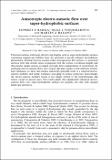| dc.contributor.author | Bazant, Martin Z. | |
| dc.contributor.author | Bahga, Supreet S. | |
| dc.contributor.author | Vinogradova, Olga I. | |
| dc.date.accessioned | 2011-02-16T18:48:34Z | |
| dc.date.available | 2011-02-16T18:48:34Z | |
| dc.date.issued | 2010-02 | |
| dc.date.submitted | 2009-10 | |
| dc.identifier.issn | 0022-1120 | |
| dc.identifier.issn | 1469-7645 | |
| dc.identifier.uri | http://hdl.handle.net/1721.1/60963 | |
| dc.description.abstract | Patterned surfaces with large effective slip lengths, such as super-hydrophobic surfaces containing trapped gas bubbles, have the potential to greatly enhance electrokinetic phenomena. Existing theories assume either homogeneous flat surfaces or patterned surfaces with thin double layers (compared with the texture correlation length) and thus predict simple surface-averaged, isotropic flows (independent of orientation). By analysing electro-osmotic flows over striped slip-stick surfaces with arbitrary double-layer thickness, we show that surface anisotropy generally leads to a tensorial electro-osmotic mobility and subtle, nonlinear averaging of surface properties. Interestingly, the electro-osmotic mobility tensor is not simply related to the hydrodynamic slip tensor, except in special cases. Our results imply that significantly enhanced electro-osmotic flows over super-hydrophobic surfaces are possible, but only with charged liquid–gas interfaces. | en_US |
| dc.description.sponsorship | National Science Foundation (U.S.) (Contract no. DMS-0707641) | en_US |
| dc.language.iso | en_US | |
| dc.publisher | Cambridge University Press | en_US |
| dc.relation.isversionof | http://dx.doi.org/10.1017/S0022112009992771 | en_US |
| dc.rights | Article is made available in accordance with the publisher's policy and may be subject to US copyright law. Please refer to the publisher's site for terms of use. | en_US |
| dc.source | MIT web domain | en_US |
| dc.title | Anisotropic electro-osmotic flow over superhydrophobic surfaces | en_US |
| dc.type | Article | en_US |
| dc.identifier.citation | Bahga, Supreet S., Olga I. Vinogradova, and Martin Z. Bazant. “Anisotropic electro-osmotic flow over super-hydrophobic surfaces.” Journal of Fluid Mechanics 644 (2010): 245. © Cambridge University Press 2010 | en_US |
| dc.contributor.department | Massachusetts Institute of Technology. Department of Chemical Engineering | en_US |
| dc.contributor.department | Massachusetts Institute of Technology. Department of Mathematics | en_US |
| dc.contributor.approver | Bazant, Martin Z. | |
| dc.contributor.mitauthor | Bazant, Martin Z. | |
| dc.relation.journal | Journal of Fluid Mechanics | en_US |
| dc.eprint.version | Final published version | en_US |
| dc.type.uri | http://purl.org/eprint/type/JournalArticle | en_US |
| eprint.status | http://purl.org/eprint/status/PeerReviewed | en_US |
| dspace.orderedauthors | BAHGA, SUPREET S.; VINOGRADOVA, OLGA I.; BAZANT, MARTIN Z. | en |
| mit.license | PUBLISHER_POLICY | en_US |
| mit.metadata.status | Complete | |
